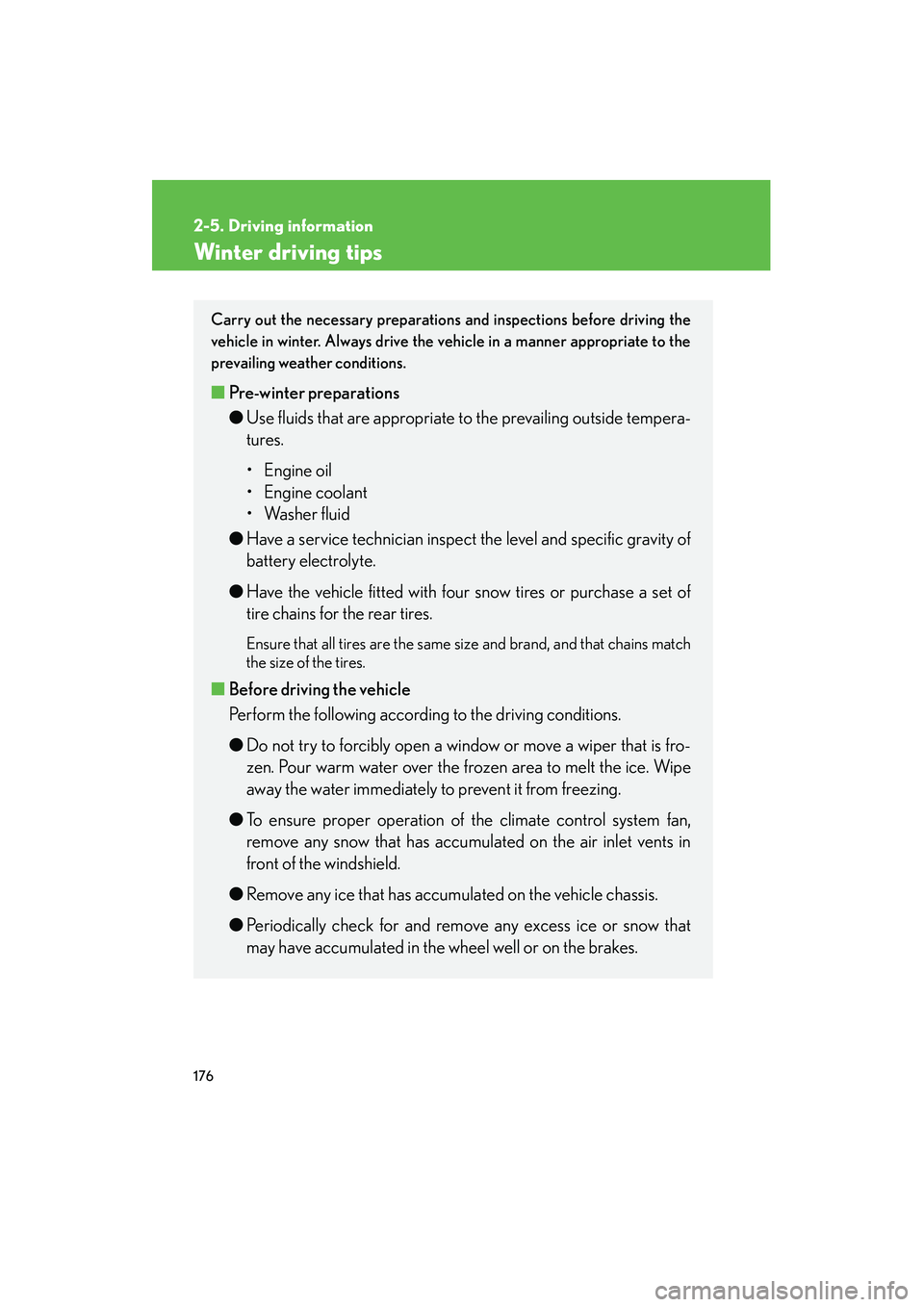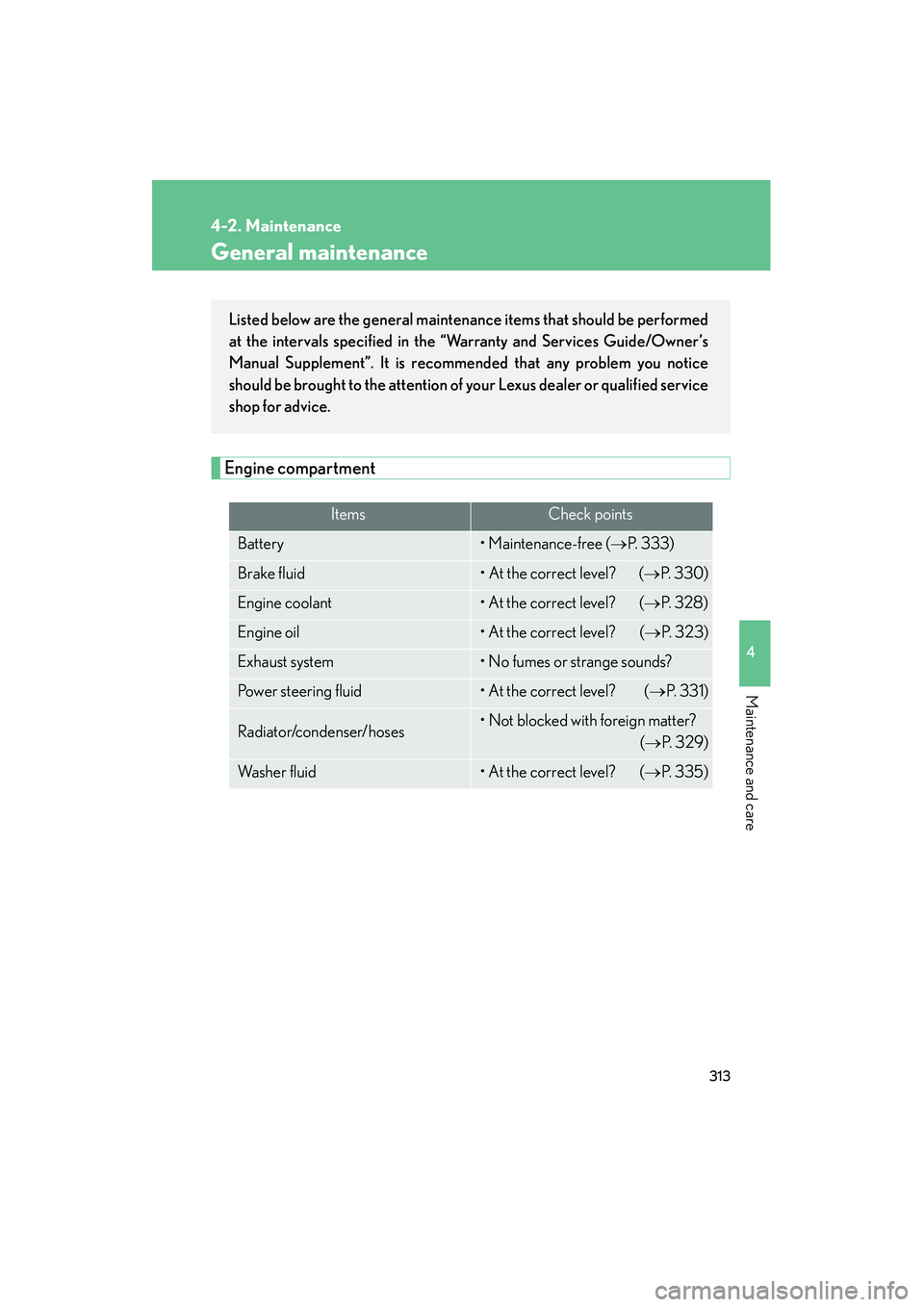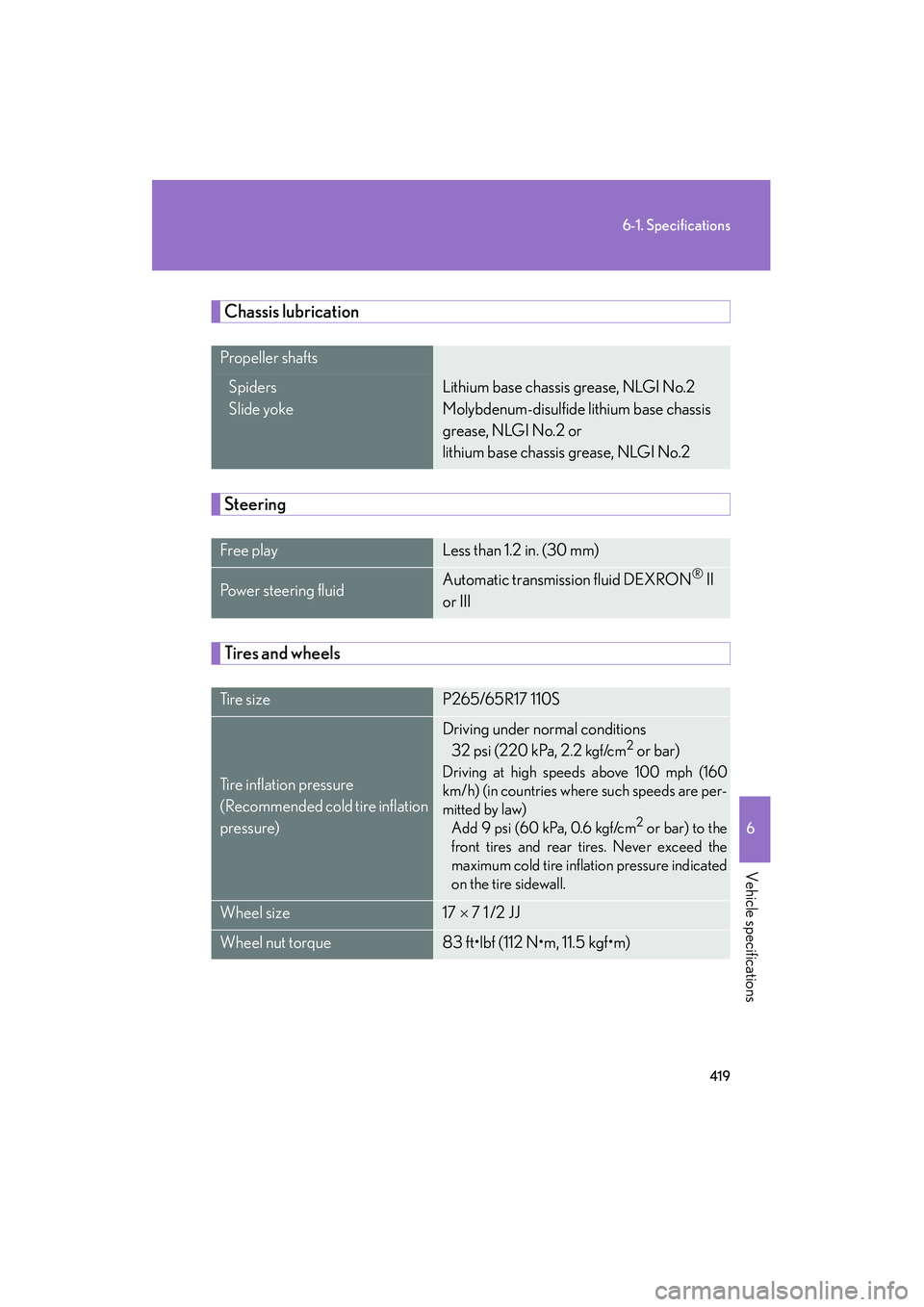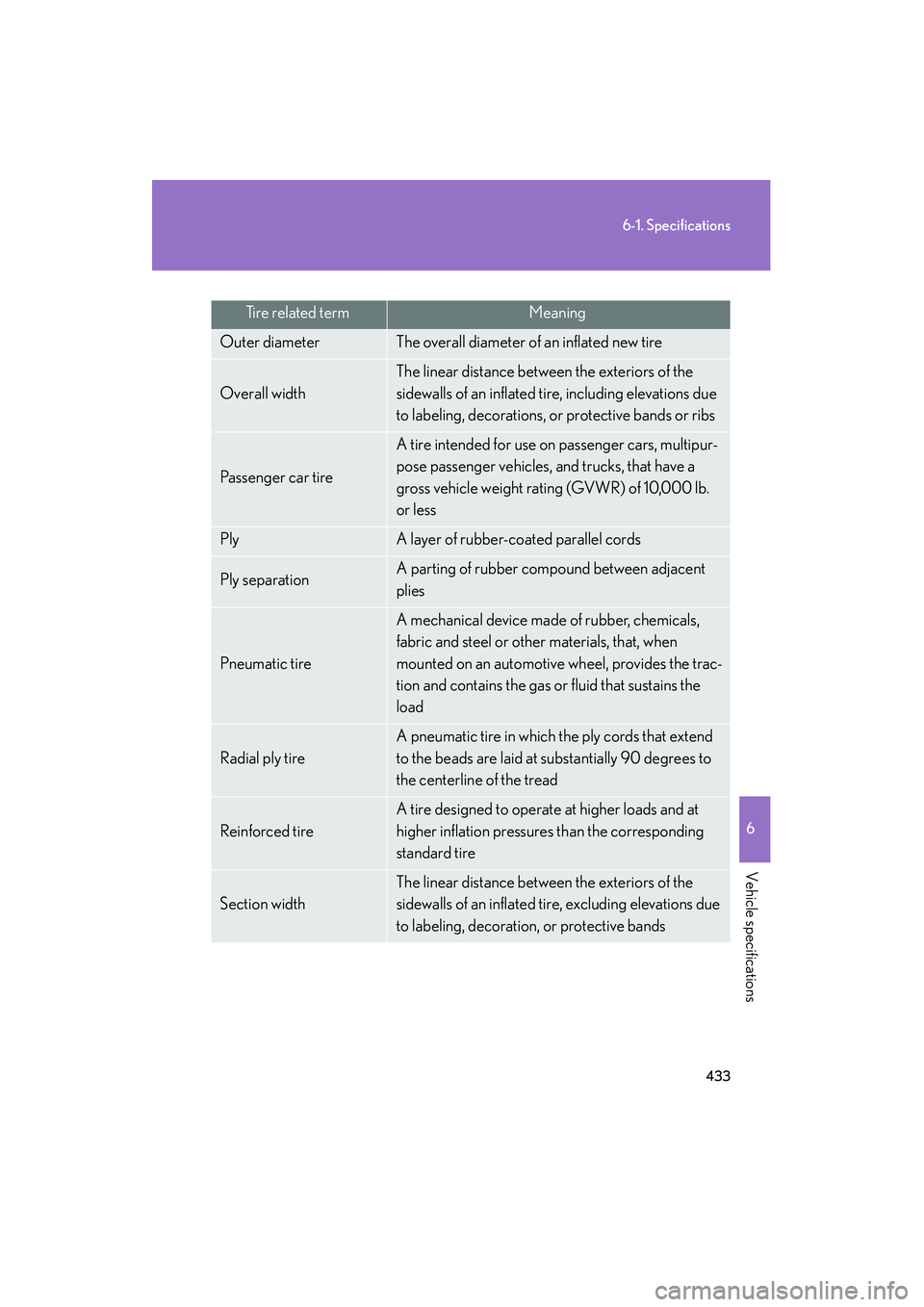2008 Lexus GX470 fluid spec
[x] Cancel search: fluid specPage 177 of 458

176
2-5. Driving information
Winter driving tips
Carry out the necessary preparations and inspections before driving the
vehicle in winter. Always drive the vehicle in a manner appropriate to the
prevailing weather conditions.
■Pre-winter preparations
●Use fluids that are appropriate to the prevailing outside tempera-
tures.
• Engine oil
• Engine coolant
• Washer fluid
● Have a service technician inspect the level and specific gravity of
battery electrolyte.
● Have the vehicle fitted with four snow tires or purchase a set of
tire chains for the rear tires.
Ensure that all tires are the same size and brand, and that chains match
the size of the tires.
■ Before driving the vehicle
Perform the following according to the driving conditions.
●Do not try to forcibly open a window or move a wiper that is fro-
zen. Pour warm water over the frozen area to melt the ice. Wipe
away the water immediately to prevent it from freezing.
● To ensure proper operation of the climate control system fan,
remove any snow that has accumulated on the air inlet vents in
front of the windshield.
● Remove any ice that has accumulated on the vehicle chassis.
● Periodically check for and remove any excess ice or snow that
may have accumulated in the wheel well or on the brakes.
Page 203 of 458

202
3-2. Using the audio system
■Using cellular phones
Interference may be heard through the audio system’s speakers if a cellular phone is
being used inside or close to the vehicle while the audio system is operating.
CAUTION
■For vehicles sold in the U.S.A. and Canada
●Pa r t 1 5 o f t h e F CC R u l e s
FCC Warning:
Any unauthorized changes or modifications to this equipment will void the user’s
authority to operate this device.
●Laser products
• Do not take this unit apart or attempt to make any changes yourself. This is an intricate unit that uses a laser pickup to retrieve information from the
surface of compact discs. The laser is carefully shielded so that its rays remain
inside the cabinet. Therefore, never try to disassemble the player or alter any
of its parts since you may be exposed to laser rays and dangerous voltages.
• This product utilizes a laser. Use of controls or adjustments or performance of procedures other than
those specified herein may result in hazardous radiation exposure.
NOTICE
■To prevent battery discharge
Do not leave the audio system on longer than necessary with the engine off.
■To avoid damaging the audio/video system
Take care not to spill drinks or other fluids over the audio system.
Page 313 of 458

312
4-2. Maintenance
■Allow inspection and repairs to be performed by a Lexus dealer
●Lexus technicians are well-trained specialists and are kept up to date with the
latest service information. They are well informed about the operations of all
systems on your vehicle.
●Keep a copy of the repair order. It proves that the maintenance that has been
performed is under warranty coverage. If any problem should arise while your
vehicle is under warranty, your Lexus dealer will promptly take care of it.
CAUTION
■Hazardous materials
●Engine exhaust, some of its constituents, and a wide variety of automobile com-
ponents contain or emit chemicals known to the State of California to cause can-
cer and birth defects and other reproductive harm. Work in a well ventilated area.
●Oils, fuels and fluids contained in vehicles as well as waste produced by compo-
nent wear contain or emit chemicals known to the State of California to cause
cancer and birth defects or other reproductive harm. Avoid exposure and wash
any affected area immediately.
●Battery posts, terminals and related accessories contain lead and lead com-
pounds which are known to cause brain damage. Wash your hands after han-
dling. (→P. 3 3 3 )
●Used engine oil contains chemicals that have been shown to cause cancer in lab-
oratory animals. Avoid prolonged and repeated contact. Always protect your
skin by washing thoroughly with soap and water.
Page 314 of 458

313
4-2. Maintenance
4
Maintenance and care
General maintenance
Engine compartment
ItemsCheck points
Battery• Maintenance-free (→P. 333)
Brake fluid• At the correct level? ( →P. 3 3 0 )
Engine coolant• At the correct level? ( →P. 3 2 8 )
Engine oil• At the correct level? ( →P. 3 2 3 )
Exhaust system• No fumes or strange sounds?
Power steering fluid• At the correct level? ( →P. 3 3 1 )
Radiator/condenser/hoses• Not blocked with foreign matter?
(→ P. 3 2 9 )
Wa s h e r f l u i d• At the correct level? ( →P. 335)
Listed below are the general maintenance items that should be performed
at the intervals specified in the “Warranty and Services Guide/Owner’s
Manual Supplement”. It is recommended that any problem you notice
should be brought to the attention of your Lexus dealer or qualified service
shop for advice.
Page 385 of 458

384
5-2. Steps to take in an emergency
Have the malfunction repaired immediately.After taking the specified steps to correct the suspected problem, check
that the warning light turns off.
Warning lightWarning light/DetailsCorrection procedure
Open door warning light A door or a back door is not
fully closed.Check that all doors and the
back door are closed.
Low fuel level warning lightRemaining fuel
(Approximately 2.9 gal. [11 L,
2.4 Imp.gal.] or less)
Refuel the vehicle.
Low washer fluid warning
lightLow level of washer fluid.
Fill the tank.
Engine oil replacement
reminder light
Illuminates for about 3 sec-
onds and then flashes for
about 12 seconds: The engine
oil is scheduled to be changed.
Check the engine oil, and
change if necessary.
Comes on and remains on:
The engine oil should be
changed.Check and change the engine
oil.
Page 419 of 458

418
6-1. Specifications
Tr a n s f e r
Automatic transmission
Brakes
*1: Minimum pedal clearance when depressed with a force of 490 N (50 kgf, 110
lbf) while the engine is running.
*2: Parking brake adjustment when depressed with a force of 196 N (20 kgf, 44lbf).
Oil capacity1.5 qt. (1.4 L, 1.2 Imp.qt.)
Oil typeHypoid gear oil API GL-5
Recommended oil viscositySAE 75W-90
Fluid capacity
Drain and refill
3.2 qt. (3.0 L, 2.6 lmp.qt.)
Fluid typeTo y o t a G e n u i n e AT F W S
NOTICE
■Automatic transmission fluid type
Using transmission fluid other than “Toyota Genuine ATF WS” may cause deterio-
ration in shift quality, locking up of your transmission accompanied by vibration, and
ultimately damage the transmission of your vehicle.
Pe d a l c l e a r a n c e *12.0 in. (52 mm) Min.
Pedal free play0.04 0.24 in. (1.0 6.0 mm)
Brake pad wear limit0.04 in. (1.0 mm)
Parking brake adjustment *25 7 clicks
Parking brake lining wear limit0.04 in. (1.0 mm)
Fluid typeSAE J1703 or FMVSS No. 116 DOT 3
Page 420 of 458

419
6-1. Specifications
6
Vehicle specifications
Chassis lubrication
Steering
Tires and wheels
Propeller shafts
Spiders
Slide yokeLithium base chassis grease, NLGI No.2
Molybdenum-disulfide lithium base chassis
grease, NLGI No.2 or
lithium base chassis grease, NLGI No.2
Free playLess than 1.2 in. (30 mm)
Power steering fluidAutomatic transmission fluid DEXRON® II
or III
Ti r e s i z eP265/65R17 110S
Tire inflation pressure
(Recommended cold tire inflation
pressure)
Driving under normal conditions 32 psi (220 kPa, 2.2
kgf/cm2 or bar)
Driving at high speeds above 100 mph (160
km/h) (in countries where such speeds are per-
mitted by law) Add 9 psi (60 kPa, 0.6 kgf/cm
2 or bar) to the
front tires and rear tires. Never exceed the
maximum cold tire inflation pressure indicated
on the tire sidewall.
Wheel size17 × 7 1 /2 JJ
Wheel nut torque83 ft•lbf (112 N•m, 11.5 kgf•m)
Page 434 of 458

433
6-1. Specifications
6
Vehicle specifications
Tire related termMeaning
Outer diameterThe overall diameter of an inflated new tire
Overall width
The linear distance between the exteriors of the
sidewalls of an inflated tire, including elevations due
to labeling, decorations, or protective bands or ribs
Passenger car tire
A tire intended for use on passenger cars, multipur-
pose passenger vehicles, and trucks, that have a
gross vehicle weight rating (GVWR) of 10,000 lb.
or less
PlyA layer of rubber-coated parallel cords
Ply separationA parting of rubber compound between adjacent
plies
Pneumatic tire
A mechanical device made of rubber, chemicals,
fabric and steel or other materials, that, when
mounted on an automotive wheel, provides the trac-
tion and contains the gas or fluid that sustains the
load
Radial ply tire
A pneumatic tire in which the ply cords that extend
to the beads are laid at substantially 90 degrees to
the centerline of the tread
Reinforced tire
A tire designed to operate at higher loads and at
higher inflation pressures than the corresponding
standard tire
Section width
The linear distance between the exteriors of the
sidewalls of an inflated tire, excluding elevations due
to labeling, decoration, or protective bands